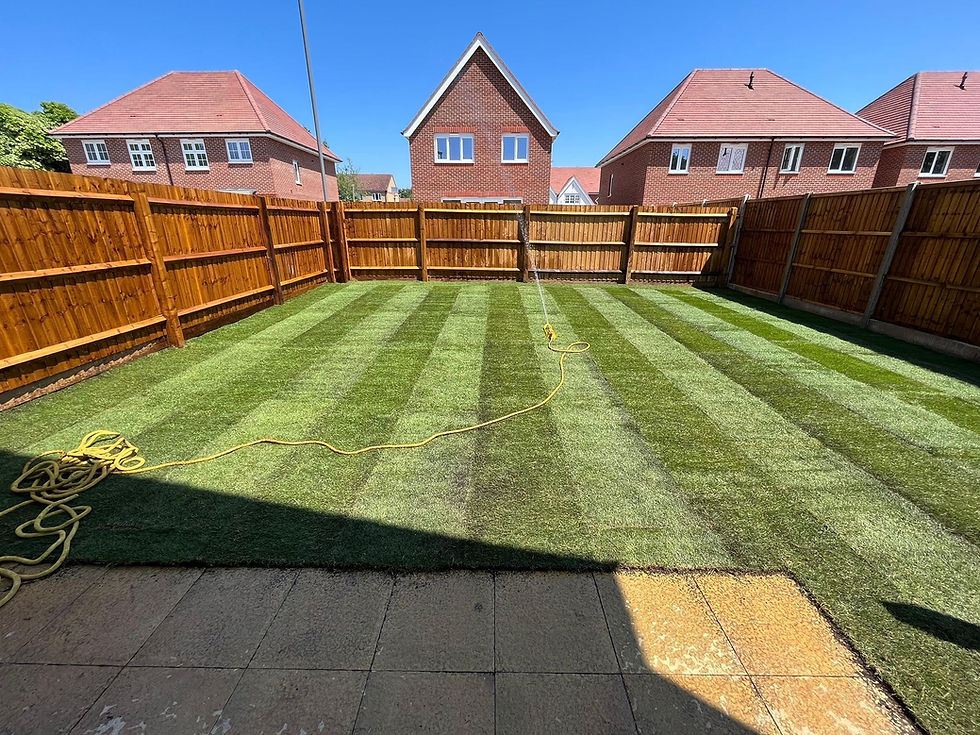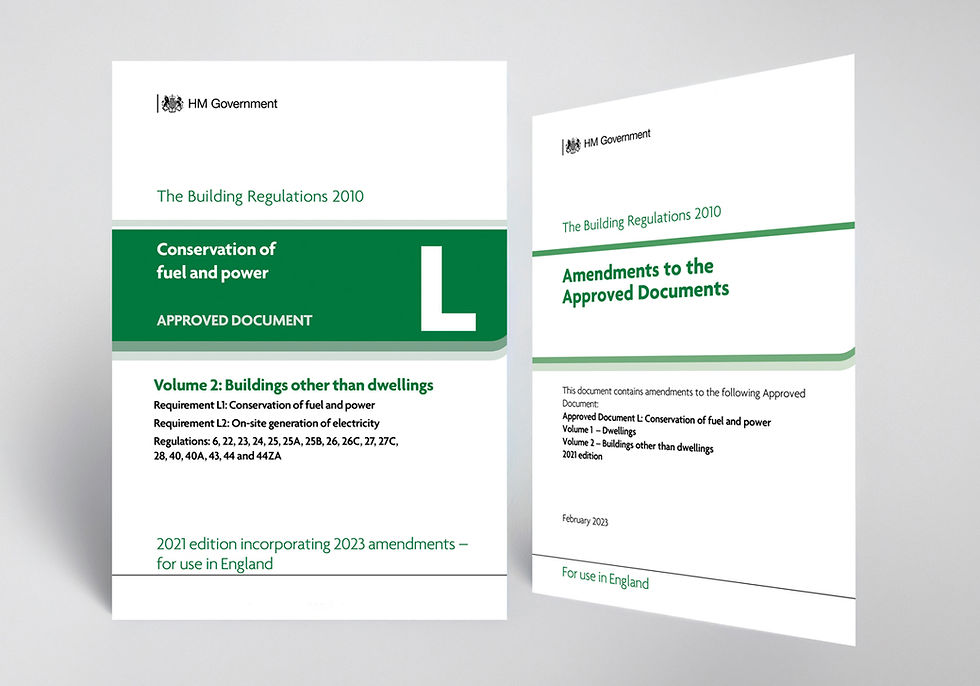Caring for Your New Lawn
- info1864854
- Apr 26
- 5 min read
Updated: May 4

A well maintained lawn can significantly enhance the appearance of your new build home, providing a pleasant outdoor space for relaxation and recreation. But for new build homeowners, caring for a lawn can feel like a daunting task, especially if it’s your first time dealing with a garden or you’ve just moved into a new home with a freshly laid lawn. Lawn care is essential not only for the beauty of your garden but also for maintaining the health and longevity of your lawn.
In this article, we’ll cover the importance of lawn care for new build homes and provide tips on how homeowners can care for their lawns to keep them lush, green, and thriving throughout the seasons.
Why Lawn Care is Important for New Build Homes
First impressions matter
When you move into a new build, your garden is one of the first things people will notice. A healthy, well-kept lawn can significantly boost your home’s curb appeal. Whether you’re looking to create a space for outdoor gatherings or simply want to make a great first impression, a vibrant lawn plays a crucial role in the overall look of your property.
Encourages healthy growth
Proper lawn care encourages healthy grass growth. A well maintained lawn provides an inviting space for outdoor activities, increases air quality, and helps regulate the temperature around your home by reducing heat in the summer months.
Increases property value
A beautifully maintained lawn can add to the overall value of your property. When it’s time to sell your home, prospective buyers will be more attracted to a well kept garden. Landscaping, including a healthy lawn, is one of the factors that can increase a home’s market value and appeal.
Prevents weeds and pests
A healthy lawn is better equipped to compete with weeds and resist pests. Proper care helps the grass to grow thicker and stronger, making it more difficult for unwanted weeds or insects to take hold and cause damage.
How to Care for Your Lawn as a New Build Homeowner
Lawn care for new build homes doesn’t have to be complicated. Here are some essential steps you can follow to maintain a beautiful lawn:
Watering
Watering is one of the most crucial aspects of lawn care, particularly in the UK where weather conditions can vary significantly throughout the year.
New grass - Newly laid lawns (often sod or turf) require frequent watering during the first few weeks to help the roots establish. Water the grass daily, or even twice a day, depending on weather conditions. This is especially important in dry spells or during hot weather.
Established grass - Once your lawn is established, watering should be less frequent. Aim for watering once or twice a week, depending on rainfall. Water early in the morning or later in the evening to prevent evaporation from the heat of the sun.
Tip: Avoid overwatering as this can lead to waterlogged soil and root rot.
Mowing
Regular mowing helps keep your lawn looking tidy and encourages healthy growth by preventing the grass from getting too long and unruly. Here are some tips for mowing:
Frequency - During the growing season (spring and summer), mow your lawn once a week. In autumn and winter, reduce mowing frequency as grass growth slows.
Mowing height - Set your mower to a higher setting, especially during the summer months. Cutting the grass too short can damage the grass and leave it vulnerable to weeds. A good rule of thumb is to never cut more than a third of the grass blade length at one time.
Edge trimming - Don’t forget the edges of your lawn. Regularly trim the edges with a strimmer or edging tool to keep the lawn looking neat and tidy.
Tip: Keep your mower blades sharp to ensure clean cuts, which will help your grass heal more quickly and resist disease.
Fertilising
Fertilising your lawn helps to replenish nutrients that are essential for healthy growth. Applying fertiliser at the right time of year can help your lawn stay strong, green, and resistant to stress.
Spring - Apply a slow-release fertiliser in early spring to encourage strong growth as the weather warms up.
Summer - During the warmer months, use a balanced fertiliser to promote healthy growth without encouraging excessive leaf production, which can weaken the grass.
Autumn - In autumn, switch to a fertiliser that is high in potassium to help prepare the lawn for winter. This will encourage the roots to grow deeper and more resilient.
Tip: Avoid over fertilising, as this can burn the grass and lead to a build up of nutrients that can harm the soil.
Aerating the soil
Over time, the soil in your lawn can become compacted, especially if the lawn receives heavy foot traffic. Aerating the soil helps water, air, and nutrients reach the roots more effectively.
When to aerate - Aerating is typically done in the spring or early autumn when the grass is actively growing.
How to aerate - Use a lawn aerator (available to rent or purchase) to create small holes in the soil. This process allows better root growth and can improve drainage, particularly in clay heavy soils.
Tip: If your lawn has heavy traffic or poor drainage, aerating regularly (every 1-2 years) will help maintain a healthy lawn.
Weed control
Weeds can quickly overtake your lawn if not properly controlled. While it’s normal to have a few weeds, an overgrowth can damage the grass and make your lawn look untidy.
Manual weeding - If you have a small number of weeds, pull them by hand to avoid using harsh chemicals. Make sure to remove the roots to prevent regrowth.
Chemical Weeding - If weeds become persistent, consider using a selective herbicide that targets specific weeds without harming the grass. Be sure to follow the manufacturer’s instructions for safe use.
Tip: Regular mowing and watering help prevent weeds from establishing themselves in the first place.
Additional Lawn Care Tips for New Build Homeowners
Soil testing - If your lawn isn’t thriving despite your best efforts, consider testing the soil’s pH and nutrient levels. Soil testing kits are available at most garden centres and can help you identify any deficiencies.
Lawn repair - If your lawn becomes damaged due to poor weather, pets, or heavy use, reseeding is a good option. Reseed any bare patches in the spring or autumn to allow new grass to establish.
Conclusion
Caring for your lawn is an ongoing task that requires attention to detail, but the effort you put in will be well worth it. A healthy, lush lawn not only improves the appearance of your new build home but also creates an outdoor space where you can relax, entertain, and enjoy nature.
By following the basic principles of lawn care; watering, mowing, fertilising, aerating, and controlling weeds; new build homeowners can ensure their lawn remains a beautiful, thriving part of their property for years to come. Whether you’re a seasoned gardener or a first time homeowner, these simple steps can help keep your lawn healthy and contribute to a greener, more inviting home environment.





